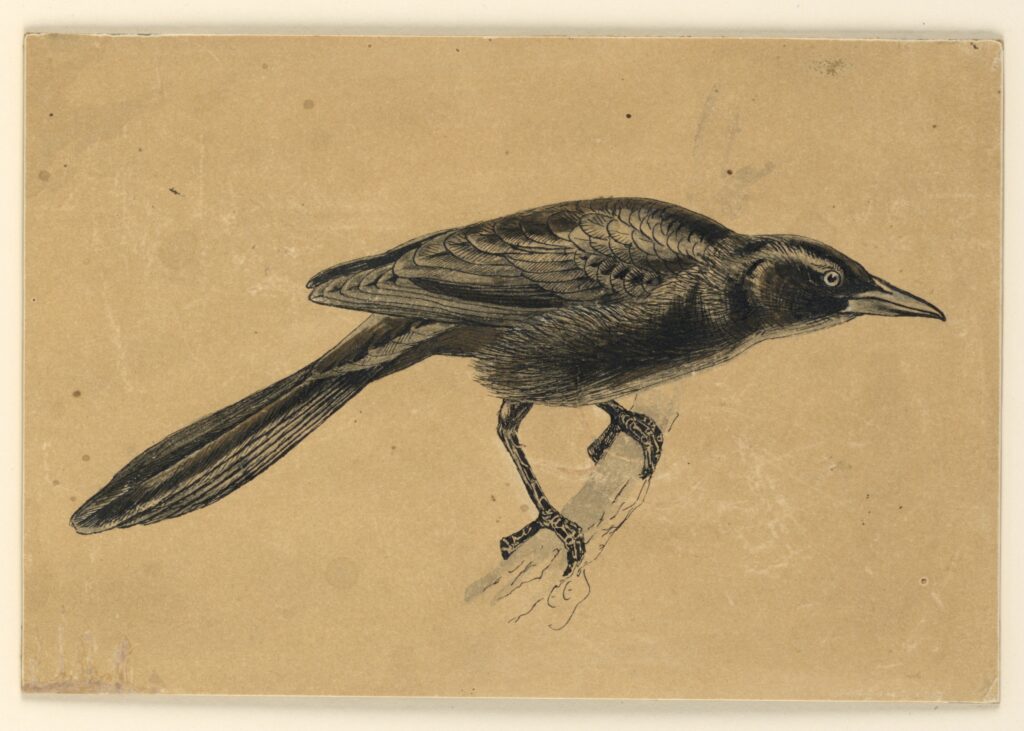Tradition of the Crows
By Louis George (Klamath)[1,2]
Annotations by Jessica Cory

The crows were once beautiful birds, loved and admired by all the fowls of the air.
The crows at that time dressed in the most gorgeous colors, and their heads were decorated with red feathers that glistened like fire when the sun reflected upon it. The crows had many servants, who attended upon them. The woodpecker was the head servant, and his helpers were the sapsuckers, yellow hammers, and the linnets. They faithfully performed their duty of combing the beautiful heads of the crows, and would now and then pluck a feather from the crow’s head and stick it in their own, at the same time making the excuse that they were pulling at a snarled feather, or picking nits from his head.
So one day the crows got very angry at losing their beautiful feathers from their heads and when the servants heard of this they immediately formed a plot against the crows.
So one morning, as the servants were attending upon the crows, they overpowered them and plucked all of their red feathers from their heads and rolled them in a heap of charcoal, thus coloring them black to this very day. Any one can see for himself, the crows are not on friendly terms with their former servants, for they still possess the red heads that the crows once had. [3]
George, Louis. “Tradition of the crows.” The Red Man, 2 no. 10 (June 1910): 42.
[1] In the original document (and on additional Carlisle School paperwork), Louis’ name is spelled “Lewis.” However, on the school application, apparently filled out by this mother, Jennie Martin, it is spelled “Louis.” Following what was likely his mother’s chosen name, I’ve used “Louis” here.
[2] Louis George is noted by the Carlisle Indian Industrial School as belonging to the Klamath Nation. Today, the Klamath Tribes encompass the Klamath, Modoc, and Yahooskin peoples. Their ancestral territory is in modern-day southwest Oregon and northern California.
[3] While it is likely that the Klamath have traditional stories involving crows or ravens, as many tribes do, I was unable to find this particular story replicated elsewhere.
Contexts
The Carlisle School, located in Pennsylvania, was the most well-known of the residential schools for Native Americans in the US, which existed from 1860 until the late 20th century. It was founded by Henry Pratt, infamous for his views on the necessity of Native American cultural destruction. Native children were forced to attend the school, where they were given new names, forbidden to speak their languages, and frequently abused and even killed. Because the Carlisle School published this Native student’s story, we should recognize how power and censorship shape such texts.
Resources for Further Study
- Becky Little explains a bit of the history behind the residential school system in the U.S., and looks specifically at the Carlisle School in particular.
- Mary Annette Pember (Red Cliff Band of Wisconsin Ojibwe) writes of her mother’s experience as a student at Saint Mary’s Catholic Indian Boarding School, exploring the intergenerational trauma, disconnection, and other long-lasting impacts that such schools caused.
Pedagogy
When teaching about the history of Native American boarding schools, it’s important to couch these forced “educations” within the larger context of attempted genocide and settler colonialism, as well as to explore the often traumatic outcomes for Native Americans for which these institutions are responsible.
- The Stanford History Education Group has some wonderful curriculums for teachers and students that provide historical context and information regarding the Carlisle Indian Industrial School.
- PBS offers a two-part series on Native American boarding schools, which contains a great deal of information written in accessible language and includes lots of pictures.
Contemporary Connections
While Canada has formerly apologized to its Indigenous citizens for the impact that the residential schools had on the affected populations (though Indigenous Canadian peoples still face systemic and individual discrimination and many scholars, such as Dian Million and Audra Simpson, have explained the complexities of reconcilliation), the United States has refused to offer any sort of apology or reconciliation to its Native peoples.